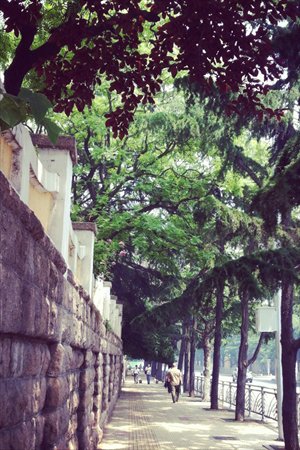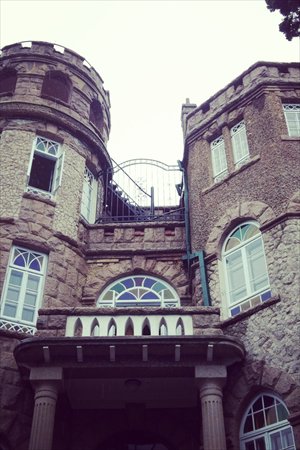

Trees line the street along Zhejiang Road. Photo: Chen Chenchen

A Western-styled building at Badaguan Photo: Chen Chenchen
There are always two camps among zealous tourists - those who'd like to know more about local culture and history, and those who favor more natural scenery. For me, I tend to lean towards culture and history if I have to choose between the two, as such the old city of Qingdao, a coastal city with a salty sea breeze and shadowy, old streets, is an ideal destination for tourists like myself.
Traveling back to the 1910s
Located in East China's Shandong province, Qingdao was a key transportation hub and all-too-important strategic foothold in the eyes of several colonial powers during the early 20th century. Strolling through the city's museums, one would be astonished by the rapidly shifting fate of the city a century ago.
During the final years of the Qing Dynasty (1644-1911), Qingdao was actually under German control. However, by the mid-1910s, as the German empire was dragged into WWI, the Japanese seized the opportunity to occupy Qingdao. Although following indignant protests by students during the May 4 Movement Qingdao was returned to the Republic of China authorities in Beijing, not long after in 1937, the Japanese invaded and occupied Qingdao again. After WWII, the city was returned to the Republic of China (1912-49)authorities in Nanjing and then in 1949, Qingdao, along with the other cities here, became a part of the People's Republic of China.
While colonial history slowly fades from the lives of residents in the city, exotic buildings with bright color and the surrounding nostalgic atmosphere stay. The seaside, stretching entire blocks of the city, could not be more relaxing. As you walk around, you may unexpectedly run into an old train station, church, post office, prison, as well as the headquarter building of the police administration or other government agencies.
From old, yellow photos displayed in local museums, one could see how street scenes looked a century ago. Today standing on the city's Zhejiang Road, one can still easily travel back in time. Tall, exuberant chinars overshadow the whole road and the buff reddish-brown little buildings on both sides. Through cut-out brick walls, one can see consulate buildings or missionary residence compounds. Summer flowers stretch across these walls, quiet and splendid.
This magic nostalgic atmosphere tints every corner of the old streets. The slow pace of life here can be felt everywhere - a stall selling dried seafood, a catholic church that holds religious events, or a Western restaurant that used to be social club where some young couples enjoy food under the shadowy trees at noon. It's pleasant to just take a walk and do nothing.
One may walk miles without even noticing it. Although you may get tired at some point, no need to worry as the old city offers good places to rest everywhere. On Daxue Road, or the road near the time-honored Ocean University of China, there are some good, small coffee shops directly facing a local art museum.
Besides coffee shops, sidewalk seafood booths are also ideal resting places for travelers. They have everything: spicy shrimp, fresh clams, simple green vegetables, local yoghurt, and of course, the city's famous Tsingtao beer.
Cooks are so efficient that the first reeky dish is delivered as soon as you finish your first bottle. It goes without saying that the seafood is incredibly fresh. Light conversation can be heard at each table, amid the smell of seafood and aroma of beer. One booth I visited was called wuming, literally nameless. This booth along with the countless other little "nameless" booths help add a unique flavor to the old city.
Walking around the city I noticed quite a number of engaged couples taking summer photos on the old streets of Qingdao. Light crosses through the heavy tree leaves and turns into vague, minor shadows on the ground. There photographers patiently guide the brides-to-be to look up and gaze at the eaves of an old building. The moment the camera button is pressed, what's taken in is not just the couple and their happiness, but also the city's history.
Historical details
Many of the city's old buildings are open to the public. Therefore there are abundant opportunities to get a glimpse of the many historical details that exist in the city. One place I recommend is the city's post office museum. Built by the Germans in the late 19th century, the first floor offers slow mail delivery services, currently very popular in China, where people can mail their postcards or letters and arrange for them to be received in years or even decades. Some of the upstairs stories are open to public, with a ticket that costs 30 yuan ($5) - 20 yuan if you follow their WeChat account. It's a very quiet museum since few people bother to go upstairs.
Besides the historical narratives and photos on the wall, narrating how the fate of this post office building changed during the semi-colonial period and wartime, more concrete artifacts are also on display - the very first phone used here a century ago, the office room used by the then head of the post administration and the very first few postcards mailed from this little office to remote, foreign continents.
In fact, the building itself is a legacy. Walking into the tall rooms, is like walking down a corridor into history. Outside the big windows are verdant tree shadows and long red brick corridors. Tender flowers sit right beside thin white yarn curtains. Burnished ceiling fans spin lightly. Everything seems like a part of a remote dream of history.
One story of the building is currently being rented out to a businessman, who is running one of the city's most famous bookstores and coffee shops there. It's a good place to stay and read for a while.
The city also has many former residences of celebrities. After taking a cup of afternoon coffee, I went to visit the residence of the famous Chinese writer Lao She. It was an independent Western-styled building. While most people know Lao She lived in Beijing and wrote many articles about the capital city, few know he spent quite a long period of time in Qingdao. It was in this very building that he finished his work, Rickshaw Boy, which is famous both at home and abroad.
On the wall of the living room on the first floor, there is a brief introduction about the background of this novel. During the Cultural Revolution (1966-76), a curator in Shanghai, risked his life to protect the manuscript of this novel. Reading these lines makes one sigh. Small details from life are clearly displayed in this building. The clothes, table, chair, bag, photos and letters belonging to the writer and donated by his daughter are kept in this building. Various translated versions of Rickshaw Boy are also on display. In one room, you can put on earphones and watch different classic film or modern drama versions of this great work.
Although his life ended with a tragic suicide, Lao She actually spent a very pleasant time in Qingdao. It's easy to imagine, as the humid breeze from the sea wrapping this seaside building makes everything seem like a dream.
Tranquil villa blocks
The weather in Qingdao can change very fast on short notice. Bright sunshine that permeates the whole city can appear very remote in the blink of an eye. When the sea wind brings rain, the city is suddenly soaked in rainfall. In a split-second, all those young couples coming out for wedding photos suddenly disappear from the streets and hide in the backseats of their vans, sitting next to the photography equipment and waiting for the rain to stop.
For me, this is a great opportunity to take a walk in Badaguan, literally the eight great passes, which is a neighborhood that includes eight streets named after eight famous military forts in ancient China. It is a neighborhood of European-style villas and mansions dating back to the early 20th century, designed by foreign architects. The variety is amazing, next door to a Russian-styled compound, you might find a French villa. In the neighborhood, the narrow paths make for a cozy evening walk. There are ponds embraced by trees here and there, and one may sit on a long bench beside a pond, idling away an afternoon reading or having a light conversation with a companion.
It is in this place that one starts to understand where the beautiful chapters by early 20th century Chinese writers come from. Many of those fragrant lines describe places just like this. At the time, the Chinese language was being reshaped through cultural and linguistic collision between the East and the West and the flames of literary inspiration were at least partly ignited by places like this - places where East met West.
Actually the whole city of Qingdao is like this - a pair of hands beckoning you to walk back along history to see the initial moment in the modern era when East met West.
Copyright ©1999-2018
Chinanews.com. All rights reserved.
Reproduction in whole or in part without permission is prohibited.